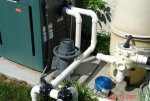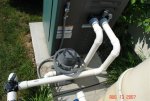Just ordered a new Autopilot Digital with SC-60 cell from Aquasuperstore and have some questions. I have a 24" horizontal run of 2"D PVC on the outlet of my Raypack gas heater which goes to the 3 way valve sending the filter/heater discharge to the pool. Based on my measurments the manifold width is enough to clear the Nature 2 manifold that is on the heater inlet pipe. Have the following install questions:
1-How best to install the manifold? Since my heater discharge is 2"D and hard piped to the 3way outlet valve, how do I glue the manifold into the 10inch space that I just cut out (the PVC may not have enough give to spring open)
2-Would I be better to use 2"D unions on the straight run of pipe vice hard gluing the manifold in?
3-If I use unions, what type should I buy to prevent leakage since this section will be under as much as 35psi pressure.
I posted this same message on the pool forum-but reposted here since I could attach a picture
1-How best to install the manifold? Since my heater discharge is 2"D and hard piped to the 3way outlet valve, how do I glue the manifold into the 10inch space that I just cut out (the PVC may not have enough give to spring open)
2-Would I be better to use 2"D unions on the straight run of pipe vice hard gluing the manifold in?
3-If I use unions, what type should I buy to prevent leakage since this section will be under as much as 35psi pressure.
I posted this same message on the pool forum-but reposted here since I could attach a picture



